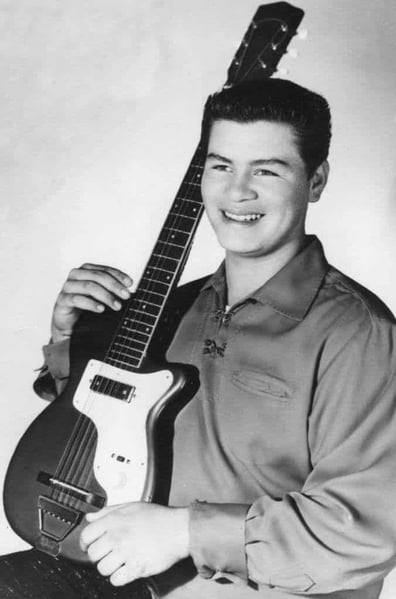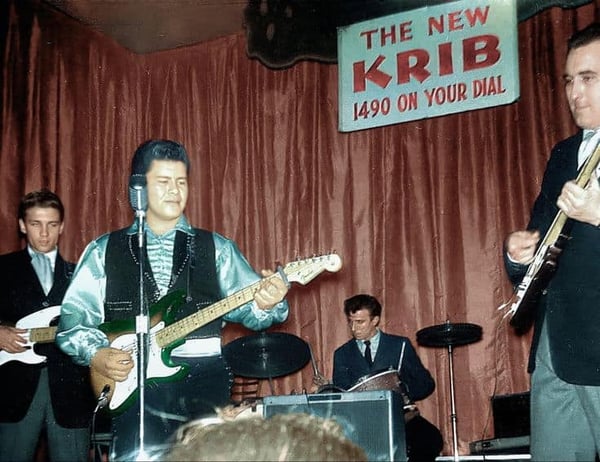Richard “Ritchie” Valens – hailed as the Father of Chicano Rock Music – left an indelible mark on the music industry despite his tragically short life. Valens displayed a natural talent for music from a young age.
He mastered the guitar and explored various musical styles, including rock and roll, blues, and traditional Mexican music.
His multicultural background, blending Mexican heritage with American rock influences, would later define his iconic sound.
Valens’ meteoric rise to fame began in the late 1950s when record producer Bob Keane discovered him.
His debut single, “Come On, Let’s Go,” released in 1958, quickly gained popularity, showcasing his distinctive blend of rockabilly and Latin rhythms. However, his groundbreaking hit, “La Bamba,” released the following year, cemented his status as a musical pioneer.
Sung entirely in Spanish, “La Bamba” became a crossover sensation, making Valens a household name in the industry.
In the following sections, we’ll examine Valens’ early life, explore the influences that shaped his musical journey, and celebrate the enduring legacy of his best single, “La Bamba.”

Credits: @catveronica1962 / Pinterest
Key Takeaway
- Ritchie Valens, known as the Father of Chicano Rock Music, was a pioneering Mexican-American guitarist, singer, and songwriter who blended various musical styles, including rock and roll, blues, and traditional Mexican music.
- Valens’ multicultural background and early exposure to music shaped his iconic sound, and his breakthrough hit single, “La Bamba,” became a crossover sensation that introduced Latin music to American audiences.
- Despite his short recording career, Valens significantly impacted the music industry in the 1950s, showcasing his exceptional vocal abilities, guitar skills, and innovative arrangements that combined different musical genres.
- Valens’ tragic death in a plane crash at the age of 17 cut his promising career short. Still, his lasting legacy continues to inspire and influence musicians, serving as a source of pride and cultural significance for Hispanic communities worldwide.
Early Life and Background

Source: depositphotos.com
The 1950s were a big deal for music. The music scene expanded back then, bringing us many talents, genres, and unforgettable hits. Alongside the established styles of country, pop, rock, jazz, blues, and gospel, another movement emerged: the Chicano movement.
The Chicano rock movement was a powerful way of promoting cultural identity and pride among Mexican-American communities. As a unique blend of rock and roll and Latin American musical styles, the Chicano rock movement represented a voice for social change and a celebration of heritage.
It’s important to note that its impact continues to inspire musicians and audiences today.
But have you ever wondered who the forefather of Chicano rock was?
It was Ritchie Valens, of course! This famous Mexican-American guitarist, singer, and songwriter was known as The first Latino rock star.
Richie Valens, born Richard Steven Valenzuela, was born in California on May 13th, 1941. He grew up in the Pacoima neighborhood, one of the city’s oldest neighborhoods, in the San Fernando Valley region of Los Angeles.
During the 1950s, Pacoima was home to a diverse community of working-class families, including many Mexican-American and African-American residents. Ritchie Valens’s parents were also working-class people.
His father was Joseph Steven Valenzuela, who did various jobs to support his family. But he was also a musician and played many music styles, including flamenco, blues, and rock. Ritchie’s family had roots in Mexico, and they used to play folk and traditional Mariachi music.
Ritchie’s parents, Joseph Valenzuela and Concepcion Reyes, encouraged him to learn to play trumpet and guitar, as he was interested in music at a very early age. He mastered guitar playing, even though he was left-handed. Despite their financial struggles and other challenges, the Valenzuela family supported Ritchie’s musical aspirations.
At Pacoima Junior High School (now Pacoima Middle School) and later at San Fernando High School, he developed his musical talents and began performing in local talent shows and events.
He often played for his classmates and performed at parties. Ritchie gained inspiration from various music genres, such as traditional Mexican mariachi and folk, rhythm and blues, and early rock.
In 1957, when he was only 16 years old, he joined a local band called The Silhouettes. They would play at parties, school events, and sometimes even concerts nearby. Richie started as a guitarist but later became the band’s main vocalist, which was a crucial moment in his career.
Discovered by Bob Keane
During a performance at a nearby theatre, Ritchie Valens caught the eye of producer Bob Keane.
Keane, a well-known talent scout, record producer, and label owner in Los Angeles, was very impressed by Valens’ guitar skills, talent, and charisma.
Keane offered Valens a contract with Del-Fi Records, but under one condition: Valens would have to create a hit song.
To his luck, Richie was determined to become a famous music star. Not long after, he recorded a demo of a song he had written titled “Come on, Let’s Go.” Keane immediately recognized the song’s potential for commercial success and arranged for Valens to re-record it with a full band. The resulting single was released in 1958.
“Come on, Let’s Go” was a great success! It reached the Billboard Hot 100 charts, encouraging Valens to drop out of high school and become a professional musician.
Keane suggested that Ritchie shorten his name to Valens. He believed a shorter and catchier name would be better and easier for audiences to remember. By shortening his name, Valens could appeal to a broader audience and potentially increase his commercial success.
As a result, Ritchie Valens became the stage name under which he achieved fame and recognition in the music world during the 1950s. Ritchie’s fame skyrocketed after his stunning performance on the famous music TV show American Bandstand.
Here’s Richie performing “Come on, Let’s Go.”https://www.youtube.com/watch?v=rEuBtgmlqI8
With Keane’s guidance, he established a considerable reputation in the highly competitive music industry.
Breakthrough Hit Single “La Bamba”

Credits: @miguelcorchon / Pinterest
Ritchie Valens became well-known in the 1950s thanks to his timeless hit song “La Bamba.” Even today, the song remains a classic that continues to captivate audiences worldwide.
The song was released in 1958 on the Del-Fi label. It was put on the B-side of “Donna” because Ritchie’s manager and producer, Bob Keane, considered that no one would listen to a song sung entirely in Spanish.
But he was very wrong: the song was Valens’ biggest hit.
This song blends traditional Mexican folk music with a modern rock rhythm. It belongs to the genre of son jarocho (Veracruz sound), a type of folk music originating from the state of Veracruz, Mexico.
It incorporates elements of Spanish, indigenous, and African musical traditions.
Ritchie put a lot of effort into singing this song. Since he was born in the US, he wasn’t fluent in Spanish, despite his Mexican descent. Hence, he needed to take Spanish lessons from his family and relatives.
Ritchie’s version of the song reached number 22 on the US Billboard Hot 100 in 1959, making it one of his most successful singles. It played an important role in introducing Latin music to American audiences.
It was ranked 354 on Rolling Stone magazine’s 500 Greatest Songs Of All Time list.
“La Bamba” is a blend of different musical styles that celebrates Valens’ Mexican-American heritage. Its catchy melody and lively rhythm have cemented its place in classic rock and Latin music history.
Short but Pioneering Recording Career
Despite his short life, Richard Valens significantly impacted the music industry in the 1950s, and his influence is still felt today.
He possessed exceptional vocal abilities that allowed him to sing various genres, from ballads to rock and roll hits. Additionally, he was a skilled guitarist, and his energetic performances with the instrument became his trademark.
Valens’ music often featured innovative arrangements that blended elements of rock and Latin music. His ability to combine different musical styles set him apart from other musicians of his time.
“La Bamba” was his most well-known hit, released in 1958. The song became a chart success and remains a timeless classic of the fifties.
“Donna” was released the same year, showing his vocal abilities and songwriting talent. The song was dedicated to his high school girlfriend, Donna Ludwig, a fan favorite.
“Come On, Let’s Go” was also a Billboard hit, representing a combination of rock and roll and Latin influence.
The romantic ballad “We Belong Together” was released in 1959 and demonstrated Valens’ versatility as a musician and ability to connect with his audience on an emotional level.
There was no denying that Valens’ impact on rock and roll was immense despite his relatively small number of hits. Even today, his music continues to hold a special place in the hearts of fans worldwide.
Tragic Death and Lasting Legacy

Credits: @buzzfeed / Pinterest
Valens was part of the Winter Dance Party Tour in 1959 along with Buddy Holly and J.P. Richardson, also known as “The Big Bopper.”
The tour took place in the Midwest of the United States and covered various states such as Wisconsin, Iowa, Minnesota, and Illinois.
It started on January 23rd in Milwaukee, Wisconsin, and ended with a performance on February 2nd in Clear Lake, Iowa. The show was the 11th of 24 scheduled events.
The tour aimed to represent rock and roll music to audiences in smaller communities during winter.
While on tour, the musicians faced unexpected mechanical issues, like traveling between venues in unheated school buses in the freezing Midwest weather.
One performer even had to be hospitalized for frostbite. The schedule was also very demanding, as they had to travel overnight in below-zero conditions.
As a solution, Buddy Holly asked his manager if a plane could be chartered to the next show in Fargo, North Dakota.
He arranged for a Beechcraft Bonanza plane to transport the band. Valens was not supposed to be on the plane, but he got a seat after winning a coin toss against Holly’s backup guitarist and musician, Tommy Allsup.
Holly’s bassist, Waylon Jennings, gave up his seat to J.P. Richardson because Richardson was sick with the flu.
On February 3rd, 1959, at approximately 12:55 a.m., a Beechcraft Bonanza carrying four passengers took off for Fargo, North Dakota.
Shortly after takeoff, the plane crashed near Clear Lake, Iowa. Ritchie was only 17 years old at the time of his death. Buddy Holly and The Big Bopper also died in a plane crash.
February 3rd, 1959, is famously known as “The Day the Music Died.”
Valens died and was buried on February 7th at San Fernando Mission cemetery. His grave became a pilgrimage site for fans of his music and those who remember his contributions to rock and roll.
He inspired the 1987 biopic film “La Bamba,” which follows his journey to stardom and his untimely death at 17.
For the film’s soundtrack, Los Lobos covered “La Bamba,” which became a massive hit and introduced Valens’ music to a new generation. The film and its soundtrack preserved his cultural legacy.
Valens was a significant figure in the music industry, influencing many musicians.
His influence extended even to the legendary Carlos Santana, who often spoke about how Valens impacted his musical style.
Other Chicano bands, including Los Lobos, Los Lonely Boys, and Thee Midniters, have also acknowledged Valens’ influence on their music.
In 2001, Valens was posthumously inducted into the Rock and Roll Hall of Fame. American Troubadour,” Don McLean paid tribute to Holly, Valens, and Richardson in his hit song “American Pie.”
On May 11th, 1990, Valens got a star on the Hollywood Walk of Fame for his contribution to music.
Ritchie Valens’ Music Lives On
Ritchie Valens was a talented and influential musician who left a significant mark on rock and roll. Despite his untimely death in a plane crash at a young age, Valens had a profound impact on the music industry during his short career.
He was a pioneer for Latino musicians in the 1950s, breaking racial barriers and paving the way for greater acceptance in the white-dominated music industry.
Valens’ music was more than just a fusion of genres; it was a bridge between cultures. Through his music, he was able to bring people together and promote cultural diversity and understanding.
Even more importantly, Valens became a role model for other Latino artists and musicians, inspiring generations to pursue their dreams and break into various entertainment and arts fields.
Today, Ritchie Valens’ legacy is a source of pride and cultural significance for Hispanic communities worldwide.
His music continues to inspire and influence artists and musicians of all backgrounds, proving that the power of music can surpass time and cultural boundaries.
